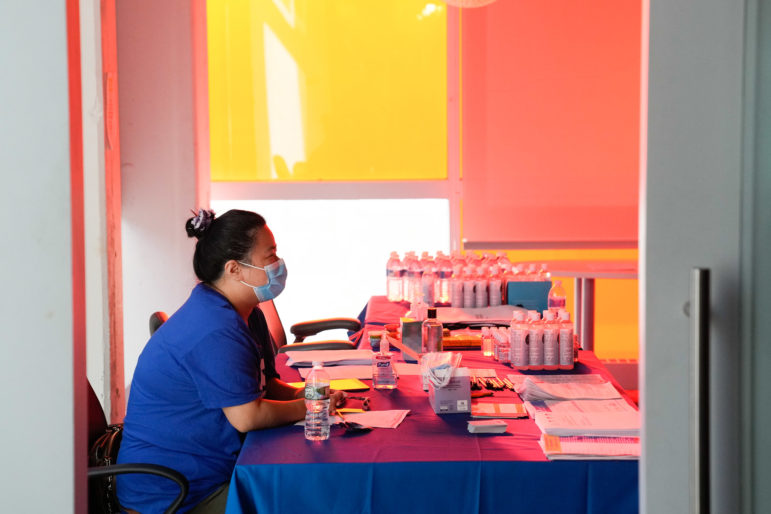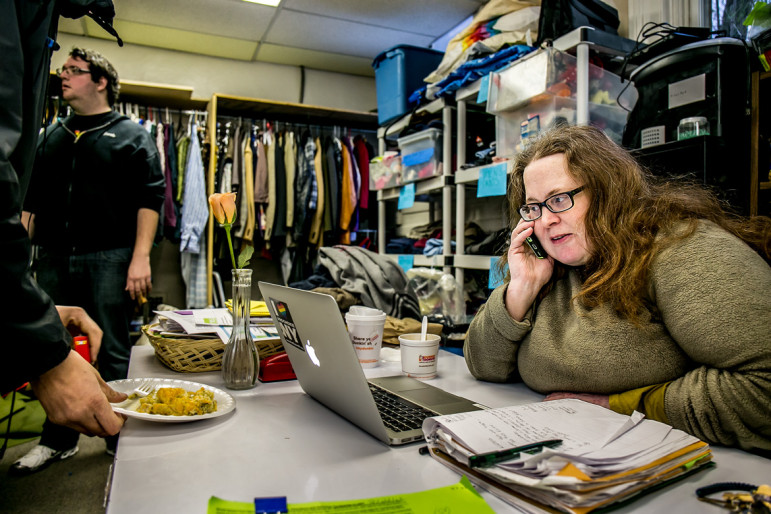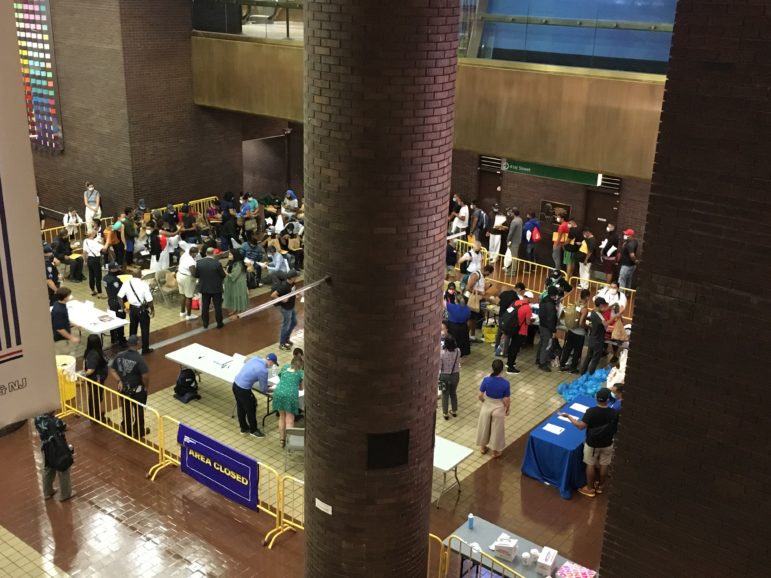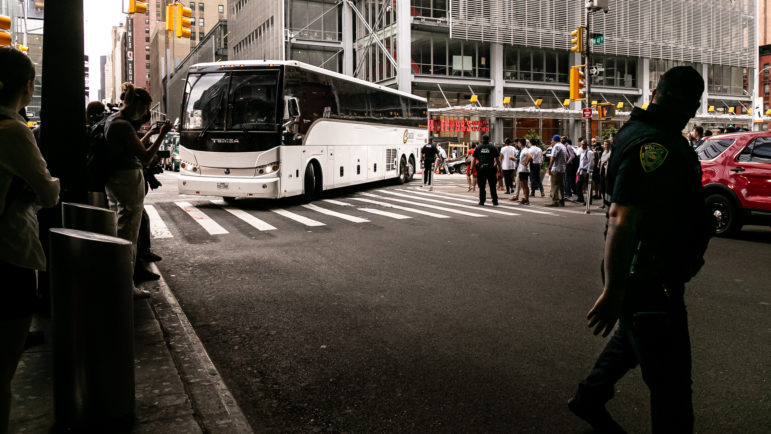Down 99 beds from this time last year, space is running out in New York City’s patchwork of shelters for teens and young adults, which provide counseling, education, job training and other services. Many who qualify for the youth shelters—including newly arrived immigrants—are instead turning to the strained Department of Homeless Services system.

Michael Appleton/Mayoral Photography Office
A worker staffs a table at the city’s new “Asylum Seeker Resource Navigation Center,” opened to assist immigrants arriving from the southern border. Providers say the uptick in younger arrivals is taxing the city’s already-strained runaway and homeless youth shelter network.Lea la versión en español aquí
A few days after his 20th birthday, David found himself sitting on the sidewalk a block away from Covenant House, New York City’s largest shelter for homeless young people. He had spent the night before in a Flushing park, the latest peril in a journey from Venezuela that took him to the five boroughs earlier this month.
David, who is seeking asylum and asked to be identified by his middle name, said he had visited Covenant House several days in a row to secure a bed, only to find out the facility was full. On Sept. 19, he held a piece of paper with the names of youth shelters and drop-in centers, along with the circled address for the Department of Homeless Services’ (DHS) men’s intake shelter on Manhattan’s East 30th Street.
When David visited, DHS staff assigned him a bed in Brooklyn’s cavernous Bedford Atlantic Armory, where hundreds of men sleep in large rooms. Few staff there spoke Spanish, David said, and services are limited, especially for a young person eager to learn English and find a job.
The next day, he again returned to Covenant House and this time caught a break: a bed was available. (Covenant House said it could not comment on an individual client’s experience.)
“Here, it is much better, of course,” David said in Spanish three days after moving in. He said he took a music class in his first week and shared a photo of himself in a studio recording over a beat: “Everything is better: the treatment, the atmosphere, even the food.”
But space is running out in New York City’s patchwork of shelters designed for homeless teens and young adults aged 16 to 24, with specialized counseling, education and job training for the developmentally distinct group. Many young people in need, including newly arrived immigrants, are instead turning to the Department of Homeless Services system, either because the youth shelters have no room or because they never learned about the unique services they can access, according to providers and young people experiencing homelessness.
The 714-bed youth shelter system administered by the Department of Youth and Community Development (DYCD) is down nearly 100 beds from a year ago, when the de Blasio administration cut ties with the shelter provider CORE Services after investigative reports into the organization’s adult shelters revealed accusations of self-dealing by the organization’s chief executive. CORE has disputed the claims. DYCD, which contracts with the providers running youth shelters, said the organization Rising Ground has picked up CORE’s contracts, but has not yet reopened the shelters while they await state approval.
The Office of Children and Family Services (OCFS), which certifies youth shelters, did not provide an opening date for those sites, but told City Limits it is “deeply committed to supporting runaway and homeless youth and their shelter needs,” and that its staff has visited the shuttered facilities. “Rising Ground and DYCD are now working with us to resolve several issues that were identified during these visits so that the facilities can be certified in the near future,” OCFS said in an emailed statement.
Jamie Powlovich, executive director for the Coalition for Homeless Youth, has urged the city and state to quickly bring those shelters back online to meet the need among newly arriving immigrants and other young people.
“The needs of immigrant youth experiencing homelessness in NYC have always largely gone unaddressed, and the recent influx of young people being bused from the border is quickly turning cracks in the system into gaping holes,” Powlovich said in an email. “The city is all but ignoring the impact and needs of the runaway and homeless youth system during this unprecedented time.”
Taxing an already-limited system
A DYCD spokesperson told City Limits that the agency has not heard from providers who are pressed for bed space. The agency’s daily census on Sept. 26 showed 18 vacant short-term crisis beds for unaccompanied homeless teens and young adults, known as “runaway homeless youth,” or RHY. The crisis beds provide short-term stays—up to 60 days—for RHY who can then move into Transitional Independent Living (TIL) programs for longer-term stays.
Staff at four RHY providers, including two that contract with DYCD, each told City Limits they have had trouble finding shelter placements, however.
Powlovich said the DYCD census data may not show a complete picture. On Sept. 26, for example, five of the vacant beds in crisis shelters were reserved for people who identify as LGBTQ+ while two were for a mother with a child. The rest, she said, were not necessarily vacant because people could have been assigned to those beds but were still awaiting intake when the census was completed. There are more beds available in TILs (data reporting errors made it unclear just how many) but clients first go through a crisis shelter before getting a TIL referral.
“Unaccompanied young people are on those buses,” Powlovich said of the buses transporting newly arrived immigrants from border states to New York. “What remains unclear is what the city is doing to support them.”
At Trinity Place on the Upper West Side, a non-DYCD funded program where residents can stay for a year and a half while they secure permanent housing, nine of 10 beds are full, said Director Wendy Kaplan. She said she is holding the 10th bed for a newly arrived immigrant transferring from another program.
“We’re getting a lot of calls from other RHY programs, as well as some sanctuary programs, for bed placement,” she said. “Unfortunately we have been full.”
Staff at The Door, which provides legal assistance, counseling and other services for young people, say they also struggle to find placements for new clients. Emely Alcantara, The Door’s RHY crisis coordinator, said that since April, about four recently arrived immigrants have visited the organization’s Lower Manhattan headquarters each week seeking services. That’s in addition to the usual flow of people, including teens and young adults kicked out of their homes in New York City along with others from outside the five boroughs.
“The biggest crisis we are facing right now is there is no availability for the youth who are coming from Texas here,” Alcantara said. “It’s unfortunate because in a perfect world, we want to find placement for everyone immediately.”
She said she and her colleagues contact drop-in centers, where young people can spend the night on a mattress on the floor, to see if there will be overnight space available. But those are sometimes full, too.
“If a young person walks into the space at 5:30, the shelters have already started their intake process and there’s a 90 percent chance they’re full already,” she said. “When that happens we’re left with very little room to make a referral.”

Adi Talwar
Kate Barnhart, executive director and founder of New Alternatives for LGBT Homeless Youth, pictured here in 2015.
Kate Barnhart, who runs New Alternatives, an organization that provides case management, life skills training and meals for homeless LGBTQ young people, said she has seen a number of newly arrived immigrants from around the world in recent months. Seven made their way to New York City from Turkey and another from the country of Georgia after first flying to Mexico, she said. All are seeking asylum because they were persecuted for being gay at home and are wary of local cultural groups they worry may be as homophobic as the native countries they fled, she said.
“It’s already hard to find beds for people in the age range, but then you add all this and it has become really difficult,” Barnhart said.
She said she could house them in the basement of her building, located across the street from the Port Authority bus terminal, but does not have enough money to pay staff. She estimated the cost would be around $6,000 per month. New Alternatives does not receive DYCD funding, but refers people to youth shelter programs that do.
“Housing is an issue,” she said. “We’ve been sticking them into youth shelters when we can but the youth shelters are completely full. Covenant House is the biggest shelter but has been posting zero beds.”
The youth shelter system grew to include 813 beds during Mayor Bill de Blasio’s tenure, an increase of roughly 600 since 2014, before dropping to 714 after the city cut out CORE. But the need long outpaced the supply. DYCD counted roughly 7,400 unaccompanied or parenting young people under age 25 without stable housing in 2018. The city identified 7,008 homeless young people in 2019 and 6,753 in 2020. Just a fraction seek spots in youth shelters, while most seek other accommodations, including spots in the DHS system.
Barnhart, Powlovich and other providers said they fear young people will be sent to the refugee camp-style set-up that the city is constructing for recently arrived immigrants in an Orchard Beach parking lot.
Spokespeople for DYCD and Mayor Eric Adams’ Office told City Limits that RHY will not be referred to the camp. People who visit the 30th Street intake shelter will not be referred to the camp either, a spokesperson for the mayor said.
It remains unclear how anyone will make it up to that site. Adams has said attendance is voluntary, meaning that people can still seek shelter in the DHS system. The goal, administration officials told reporters on a phone call earlier this month, is to direct buses arriving from the border to the camp, but that will be hard to coordinate because people are arriving in various ways and at different times.
The New York Immigration Coalition (NYIC) has urged Adams to reconsider the plan. “Any effort to open a temporary relief camp at Orchard Beach is ridiculous and likely to cause more harm than good,” said NYIC Executive Director Murad Awawdeh. On Friday, Immigration Committee Chair, Council Member Shahana Hanif, alongside elected officials and advocates, will rally opposing the “planned refugee camp,” followed later by a hearing on asylum seekers.
Jayne Bigelsen, the vice president of advocacy at Covenant House, said the youth homeless system is trying to take in as many people as possible. “It’s our responsibility as New Yorkers to show the world the right way to welcome people,” Bigelsen said.

Daniel Parra
Crowds of asylum seekers bused in from southern border states wait in line at Port Authority in August.
Approaching capacity
Blocks from Port Authority, Covenant House provides the best chance for a young person to find a shelter bed. The organization’s newly opened residence has room for 120 people and individuals can walk in to complete intake and request an available bed. On Sept. 26, there were six spots available.
A week earlier when City Limits visited, a group of about 10 Spanish-speakers passed through the exit doors. One, an 18-year-old named Freddy, had encouraged David to continue visiting the facility to secure a bed. The pair met while crossing the treacherous Darien Gap between Colombia and Panama and later reconnected on a bus from Texas to Washington, D.C., where they were sent by Gov. Greg Abbott, before heading on to New York City.
“There are more opportunities here,” said Freddy, who also traveled from Venezuela. “Music, soccer, work.”
Bigelsen said the organization has found space for most of the young people between 16 and 21 who visit, but she worries that could soon end. “This system is stretched pretty thin,” Bigelsen said, “I think if the buses continue then we need some new shelters because we are at capacity.”
During a tour of the building, Bigelsen showed off a classroom, where residents learn job skills. A bright outdoor patio and a large common area provided respite for young people. “It’s not just shelter,” Bigelsen said. “It’s education. Mental health is huge. So it’s better for this age group.”
Covenant House also provides legal services through their single on-site attorney, David Miranda, a former public defender now tasked with mastering immigration law. About 36 newly arrived immigrants and asylum-seekers are staying at Covenant House. Most have come to New York City from Venezuela, but some have journeyed from West Africa and China, Miranda said. All of them are on his caseload, along with another 15 people who have left Covenant House but still rely on him for their asylum case and other immigration court needs.
“They are the most incredible young people that I’ve ever met, and the amount of resilience it’s just, to me, it’s incredible,” Miranda said.
Before December of last year when staff noticed an uptick, Covenant House received between four or five asylum seekers in a typical year, said Miranda. But that soon began to change and what were a few became a dozen by March; and about 20 by the time the busloads of immigrants began arriving from Texas.
But legal services, like shelter space, are stretched thin. Recently arrived immigrants have faced a dearth of pro bono attorneys who can represent them in court, Documented reported earlier this month.
“We need more lawyers,” Miranda said.
The network of RHY service providers is tight-knit, and Miranda has worked with attorneys from The Door, which has a 45-person legal team with 25 lawyers working on immigration matters. They’re also finding it difficult to take on new clients, said Beth Baltimore, the head of The Door’s pro bono legal practice.
The newly arrived immigrants added to a deep backlog of cases resulting from court closures in the early months of the pandemic, Baltimore said. “I have never seen a waiting list this long and such a high need that we can’t even come close to meeting,” she said.

Adi Talwar
The first of three buses from the Texas border arriving at Port Authority in Midtown Manhattan on Aug. 10.
‘Like it looks in the movies’
For David, Covenant House has provided the first sense of stability he has had since arriving in the United States earlier this month.
After a short stay in detention in Eagle Pass, Texas, and after spending a couple of days in a shelter there, he was offered a bus to Washington, D.C. “I wanted to go to Miami, but they gave me a ticket to Washington,” David said. On the bus he saw Freddy again, whom he had not seen since the jungle crossing, and they became friends.
In the country’s capital, David did not have any acquaintances or relatives. The closest one was in New York, so he traveled to Queens, where a cousin offered a place to stay. A couple of weeks later, the cousin immediately demanded rent from David, who only just secured a part-time job washing cars. When he couldn’t pay, the cousin kicked him out. He spent nights in a nearby park before heading to Manhattan for a space in the adult shelter system. He lost the car-wash gig.
He said he now hopes to resume working as soon as possible, take English classes and finish high school. Covenant House offers programs to help people enroll in transfer high schools or earn their GED, as well as job training for information technology, security, nursing and cosmetology.
“They asked me if I wanted to continue studying, but I told them ‘no,’” David said. “My priority is finding a job.”
But he is also excited about the organization’s musical offerings. His YouTube page features a video of him singing and rapping in a studio last year and he was excited to see Covenant House had one too. “I was thrilled to see a computer, a microphone, speakers,” he said.
He will soon have to start his asylum case. The window for applying opens as soon as a person enters the country and closes after one year.
David said New York City was not his desired destination, but now he hopes to make a home here. Friends back in Venezuela are jealous when he shares videos from Times Square, he said. He was especially awed by the giant H&M store.
“New York is like it looks in the movies,” he said.








